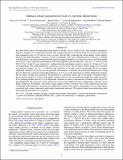THERMAL PHASE VARIATIONS OF WASP-12b: DEFYING PREDICTIONS
Author(s)
Cowan, Nicolas B.; Machalek, Pavel; Shekhtman, Louis M.; Burrows, Adam; Deming, Drake; Greene, Tom; Hora, Joseph L.; Croll, Bryce J.; ... Show more Show less
DownloadCowan-2012-THERMAL PHASE VARIAT.pdf (3.100Mb)
PUBLISHER_POLICY
Publisher Policy
Article is made available in accordance with the publisher's policy and may be subject to US copyright law. Please refer to the publisher's site for terms of use.
Terms of use
Metadata
Show full item recordAbstract
We report Warm Spitzer full-orbit phase observations of WASP-12b at 3.6 and 4.5 μm. This extremely inflated hot Jupiter is thought to be overflowing its Roche lobe, undergoing mass loss and accretion onto its host star, and has been claimed to have a C/O ratio in excess of unity. We are able to measure the transit depths, eclipse depths, thermal and ellipsoidal phase variations at both wavelengths. The large-amplitude phase variations, combined with the planet's previously measured dayside spectral energy distribution, are indicative of non-zero Bond albedo and very poor day-night heat redistribution. The transit depths in the mid-infrared—(R[subscript p] [over R [subscript *]])[superscript 2] = 0.0123(3) and 0.0111(3) at 3.6 and 4.5 μm, respectively—indicate that the atmospheric opacity is greater at 3.6 than at 4.5 μm, in disagreement with model predictions, irrespective of C/O ratio. The secondary eclipse depths are consistent with previous studies: F [subscript day] [over F [subscript *]] = 0.0038(4) and 0.0039(3) at 3.6 and 4.5 μm, respectively. We do not detect ellipsoidal variations at 3.6 μm, but our parameter uncertainties—estimated via prayer-bead Monte Carlo—keep this non-detection consistent with model predictions. At 4.5 μm, on the other hand, we detect ellipsoidal variations that are much stronger than predicted. If interpreted as a geometric effect due to the planet's elongated shape, these variations imply a 3:2 ratio for the planet's longest:shortest axes and a relatively bright day-night terminator. If we instead presume that the 4.5 μm ellipsoidal variations are due to uncorrected systematic noise and we fix the amplitude of the variations to zero, the best-fit 4.5 μm transit depth becomes commensurate with the 3.6 μm depth, within the uncertainties. The relative transit depths are then consistent with a solar composition and short scale height at the terminator. Assuming zero ellipsoidal variations also yields a much deeper 4.5 μm eclipse depth, consistent with a solar composition and modest temperature inversion. We suggest future observations that could distinguish between these two scenarios.
Date issued
2012-02Department
Massachusetts Institute of Technology. Department of Physics; MIT Kavli Institute for Astrophysics and Space ResearchJournal
Astrophysical Journal
Publisher
IOP Publishing
Citation
Cowan, Nicolas B., Pavel Machalek, Bryce Croll, Louis M. Shekhtman, Adam Burrows, Drake Deming, Tom Greene, and Joseph L. Hora. “THERMAL PHASE VARIATIONS OF WASP-12b: DEFYING PREDICTIONS.” The Astrophysical Journal 747, no. 1 (February 15, 2012): 82. © 2012 The American Astronomical Society
Version: Final published version
ISSN
0004-637X
1538-4357